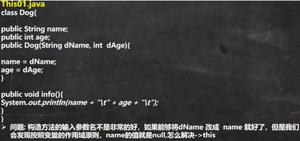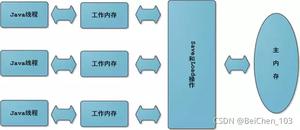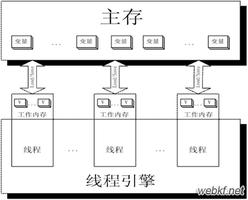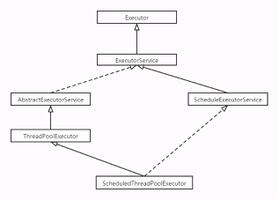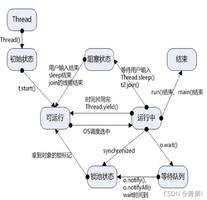Java多线程 volatile关键字详解
volatile是一种轻量同步机制。请看例子
MyThread25类
public class MyThread25 extends Thread{
private boolean isRunning = true;
public boolean isRunning()
{
return isRunning;
}
public void setRunning(boolean isRunning)
{
this.isRunning = isRunning;
}
public void run()
{
System.out.println("进入run了");
while (isRunning == true){}
System.out.println("线程被停止了");
}
public static void main(String[] args) throws InterruptedException {
MyThread25 mt = new MyThread25();
mt.start();
Thread.sleep(1000);
mt.setRunning(false);
System.out.println("已设置为false");
}
}
输出结果如下
进入run了
已设置为false
为什么程序始终不结束?说明mt.setRunning(false);没有起作用。
这里我们说下Java内存模型(JMM)
java虚拟机有自己的内存模型(Java Memory Model,JMM),JMM可以屏蔽掉各种硬件和操作系统的内存访问差异,以实现让java程序在各种平台下都能达到一致的内存访问效果。
JMM定义了线程和主内存之间的抽象关系:共享变量存储在主内存(Main Memory)中,每个线程都有一个私有的本地内存(Local Memory),本地内存保存了被该线程使用到的主内存的副本,线程对变量的所有操作都必须在本地内存中进行,而不能直接读写主内存中的变量。这三者之间的交互关系如下
出现上述运行结果的原因是,主内存isRunning = true, mt.setRunning(false)设置主内存isRunning = false,本地内存中isRunning仍然是true,线程用的是本地内存,所以进入了死循环。
在isRunning前加上volatile
private volatile boolean isRunning = true;
输出结果如下
进入run了
已设置为false
线程被停止了
volatile不能保证原子类线程安全
先看例子
MyThread26_0类,用volatile修饰num
public class MyThread26_0 extends Thread {
public static volatile int num = 0;
//使用CountDownLatch来等待计算线程执行完
static CountDownLatch countDownLatch = new CountDownLatch(30);
@Override
public void run() {
for(int j=0;j<1000;j++){
num++;//自加操作
}
countDownLatch.countDown();
}
public static void main(String[] args) throws InterruptedException {
MyThread26_0[] mt = new MyThread26_0[30];
//开启30个线程进行累加操作
for(int i=0;i<mt.length;i++){
mt[i] = new MyThread26_0();
}
for(int i=0;i<mt.length;i++){
mt[i].start();
}
//等待计算线程执行完
countDownLatch.await();
System.out.println(num);
}
}
输出结果如下
25886
理论上,应该输出30000。原子操作表示一段操作是不可分割的,因为num++不是原子操作,这样会出现线程对过期的num进行自增,此时其他线程已经对num进行了自增。
num++分三步:读取、加一、赋值。
结论:
volatile只会对单个的的变量读写具有原子性,像num++这种复合操作volatile是无法保证其原子性的
解决方法:
用原子类AtomicInteger的incrementAndGet方法自增
public class MyThread26_1 extends Thread {
//使用原子操作类
public static AtomicInteger num = new AtomicInteger(0);
//使用CountDownLatch来等待计算线程执行完
static CountDownLatch countDownLatch = new CountDownLatch(30);
@Override
public void run() {
for(int j=0;j<1000;j++){
num.incrementAndGet();//原子性的num++,通过循环CAS方式
}
countDownLatch.countDown();
}
public static void main(String []args) throws InterruptedException {
MyThread26_1[] mt = new MyThread26_1[30];
//开启30个线程进行累加操作
for(int i=0;i<mt.length;i++){
mt[i] = new MyThread26_1();
}
for(int i=0;i<mt.length;i++){
mt[i].start();
}
//等待计算线程执行完
countDownLatch.await();
System.out.println(num);
}
}
输出结果如下
30000
原子类方法组合使用线程不安全
例子如下
ThreadDomain27类
public class ThreadDomain27 {
public static AtomicInteger aiRef = new AtomicInteger();
public void addNum()
{
System.out.println(Thread.currentThread().getName() + "加了100之后的结果:" + aiRef.addAndGet(100));
aiRef.getAndAdd(1);
}
}
MyThread27类
public class MyThread27 extends Thread{
private ThreadDomain27 td;
public MyThread27(ThreadDomain27 td)
{
this.td = td;
}
public void run()
{
td.addNum();
}
public static void main(String[] args)
{
try
{
ThreadDomain27 td = new ThreadDomain27();
MyThread27[] mt = new MyThread27[5];
for (int i = 0; i < mt.length; i++)
{
mt[i] = new MyThread27(td);
}
for (int i = 0; i < mt.length; i++)
{
mt[i].start();
}
Thread.sleep(1000);
System.out.println(ThreadDomain27.aiRef.get());
}
catch (InterruptedException e)
{
e.printStackTrace();
}
}
}
输出结果如下
Thread-2加了100之后的结果:100
Thread-3加了100之后的结果:200
Thread-0加了100之后的结果:302
Thread-1加了100之后的结果:403
Thread-4加了100之后的结果:504
505
理想的输出结果是100,201,302...,因为addAndGet方法和getAndAdd方法构成的addNum不是原子操作。
解决该问题只需要在addNum加上synchronized关键字。
输出结果如下
Thread-1加了100之后的结果:100
Thread-0加了100之后的结果:201
Thread-2加了100之后的结果:302
Thread-3加了100之后的结果:403
Thread-4加了100之后的结果:504
505
结论:
volatile解决的是变量在多个线程之间的可见性,但是无法保证原子性。
synchronized不仅保障了原子性外,也保障了可见性。
volatile和synchronized比较
先看实例,使用volatile是什么效果
CountDownLatch保证10个线程都能执行完成,当然你也可以在System.out.println(test.inc);之前使用Thread.sleep(xxx)
public class MyThread28 {
//使用CountDownLatch来等待计算线程执行完
static CountDownLatch countDownLatch = new CountDownLatch(10);
public volatile int inc = 0;
public void increase() {
inc++;
}
public static synchronized void main(String[] args) throws InterruptedException {
final MyThread28 test = new MyThread28();
for(int i=0;i<10;i++){
new Thread(){
public void run() {
for(int j=0;j<1000;j++)
test.increase();
countDownLatch.countDown();
}
}.start();
}
countDownLatch.await();
System.out.println(test.inc);
}
}
运行结果如下
9677
每次运行结果都不一致。刚才我已经解释过,这里我再解释一遍。
使用volatile修饰int型变量i,多个线程同时进行i++操作。比如有两个线程A和B对volatile修饰的i进行i++操作,i的初始值是0,A线程执行i++时从本地内存刚读取了i的值0(i++不是原子操作),就切换到B线程了,B线程从本地内存中读取i的值也为0,然后就切换到A线程继续执行i++操作,完成后i就为1了,接着切换到B线程,因为之前已经读取过了,所以继续执行i++操作,最后的结果i就为1了。同理可以解释为什么每次运行结果都是小于10000的数字。
解决方法:
使用synchronized关键字
public class MyThread28 {
//使用CountDownLatch来等待计算线程执行完
static CountDownLatch countDownLatch = new CountDownLatch(10);
public int inc = 0;
public synchronized void increase() {
inc++;
}
public static synchronized void main(String[] args) throws InterruptedException {
final MyThread28 test = new MyThread28();
for(int i=0;i<10;i++){
new Thread(){
public void run() {
for(int j=0;j<1000;j++)
test.increase();
countDownLatch.countDown();
}
}.start();
}
countDownLatch.await();
System.out.println(test.inc);
}
}
输出结果如下
10000
synchronized不管是否是原子操作,它能保证同一时刻只有一个线程获取锁执行同步代码,会阻塞其他线程。
结论:
- volatile只能用在变量,synchronized可以在变量、方法上使用。
- volatile不会造成线程阻塞,synchronized会造成线程阻塞。
- volatile效率比synchronized高。
以上是 Java多线程 volatile关键字详解 的全部内容, 来源链接: utcz.com/z/332554.html

